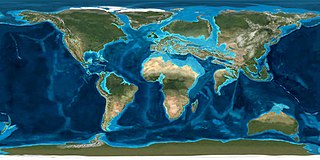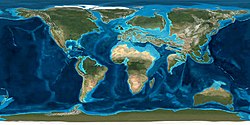
The Cenozoic is Earth's current geological era, representing the last 66 million years of Earth's history. It is characterised by the dominance of mammals, birds, and angiosperms. It is the latest of three geological eras, preceded by the Mesozoic and Paleozoic. The Cenozoic started with the Cretaceous–Paleogene extinction event, when many species, including the non-avian dinosaurs, became extinct in an event attributed by most experts to the impact of a large asteroid or other celestial body, the Chicxulub impactor.

The Eocene is a geological epoch that lasted from about 56 to 33.9 million years ago (Ma). It is the second epoch of the Paleogene Period in the modern Cenozoic Era. The name Eocene comes from the Ancient Greek ἠώς and καινός and refers to the "dawn" of modern ('new') fauna that appeared during the epoch.

The Paleogene Period is a geologic period and system that spans 43 million years from the end of the Cretaceous Period 66 million years ago (Mya) to the beginning of the Neogene Period 23.03 Mya. It is the first part of the Cenozoic Era of the present Phanerozoic Eon. The earlier term Tertiary Period was used to define the time now covered by the Paleogene Period and subsequent Neogene Period; despite no longer being recognized as a formal stratigraphic term, "Tertiary" still sometimes remains in informal use. Paleogene is often abbreviated "Pg", although the United States Geological Survey uses the abbreviation "Pe" for the Paleogene on the Survey's geologic maps.

The Paleocene–Eocene thermal maximum (PETM), alternatively "Eocene thermal maximum 1" (ETM1), and formerly known as the "Initial Eocene" or "Late Paleocene thermal maximum", was a geologically brief time interval characterized by a 5–8 °C global average temperature rise and massive input of carbon into the ocean and atmosphere. The event began, now formally, at the time boundary between the Paleocene and Eocene geological epochs. The exact age and duration of the PETM remain uncertain, but it occurred around 55.8 million years ago (Ma) and lasted about 200 thousand years (Ka). The entire warm period lasted for about 200,000 years. Global temperatures increased by 5–8 °C.
The Bartonian is, in the International Commission on Stratigraphy's (ICS) geologic time scale, a stage or age in the middle of the Eocene Epoch or Series. The Bartonian Age spans the time between 41.2 and37.71 Ma. It is preceded by the Lutetian and is followed by the Priabonian Age.
The Danian is the oldest age or lowest stage of the Paleocene Epoch or Series, of the Paleogene Period or System, and of the Cenozoic Era or Erathem. The beginning of the Danian is at the Cretaceous–Paleogene extinction event 66 Ma. The age ended 61.6 Ma, being followed by the Selandian.
The Selandian is a stage in the Paleocene. It spans the time between 61.6 and59.2 Ma. It is preceded by the Danian and followed by the Thanetian. Sometimes the Paleocene is subdivided in subepochs, in which the Selandian forms the "middle Paleocene".
The Thanetian is, in the ICS Geologic timescale, the latest age or uppermost stratigraphic stage of the Paleocene Epoch or Series. It spans the time between 59.2 and56 Ma. The Thanetian is preceded by the Selandian Age and followed by the Ypresian Age. The Thanetian is sometimes referred to as the Late Paleocene.
The Lutetian is, in the geologic timescale, a stage or age in the Eocene. It spans the time between 47.8 and41.2 Ma. The Lutetian is preceded by the Ypresian and is followed by the Bartonian. Together with the Bartonian it is sometimes referred to as the Middle Eocene Subepoch.
The Priabonian is, in the ICS's geologic timescale, the latest age or the upper stage of the Eocene Epoch or Series. It spans the time between 37.71 and33.9 Ma. The Priabonian is preceded by the Bartonian and is followed by the Rupelian, the lowest stage of the Oligocene.
The Rupelian is, in the geologic timescale, the older of two ages or the lower of two stages of the Oligocene Epoch/Series. It spans the time between 33.9 and27.82 Ma. It is preceded by the Priabonian Stage and is followed by the Chattian Stage.
The Chattian is, in the geologic timescale, the younger of two ages or upper of two stages of the Oligocene Epoch/Series. It spans the time between 27.82 and23.03 Ma. The Chattian is preceded by the Rupelian and is followed by the Aquitanian.
The Paleocene, or Palaeocene, is a geological epoch that lasted from about 66 to 56 million years ago (mya). It is the first epoch of the Paleogene Period in the modern Cenozoic Era. The name is a combination of the Ancient Greek παλαιός palaiós meaning "old" and the Eocene Epoch, translating to "the old part of the Eocene".
The Ieper Group is a group of rock strata in the subsurface of northwest Belgium. The group is subdivided into three marine formations, all formed during the Ypresian, a single age of the geologic timescale. Both age and group are named after the West Flemish town of Ypres, for which the Dutch name is "Ieper".
The Tielt Formation is a geologic formation in the subsurface of Belgium. The formation crops out in the north of Hainaut, in the southern and central parts of West- and East Flanders and in Walloon and Flemish Brabant. It consists of marine very fine sand and silt, deposited in the shallow sea that covered Belgium during the middle and late Ypresian age.
The Kortrijk Formation is a geologic formation in the Belgian subsurface. This formation crops out in northern Hainaut, southern West and East Flanders and in Walloon Brabant. The formation consists of marine clay from the Ypresian age.
Eocene Thermal Maximum 2 (ETM-2), also called H-1 or Elmo, was a transient period of global warming that occurred around 54 Ma. It was the second major hyperthermal that punctuated long-term warming from the Late Paleocene through the Early Eocene.
A hyperthermal event corresponds to a sudden warming of the planet on a geologic time scale.
The Early Eocene Climatic Optimum (EECO), also referred to as the Early Eocene Thermal Maximum (EETM), was a period of extremely warm greenhouse climatic conditions during the Eocene epoch. The EECO represented the hottest sustained interval of the Cenozoic era and one of the hottest periods in all of Earth's history.





